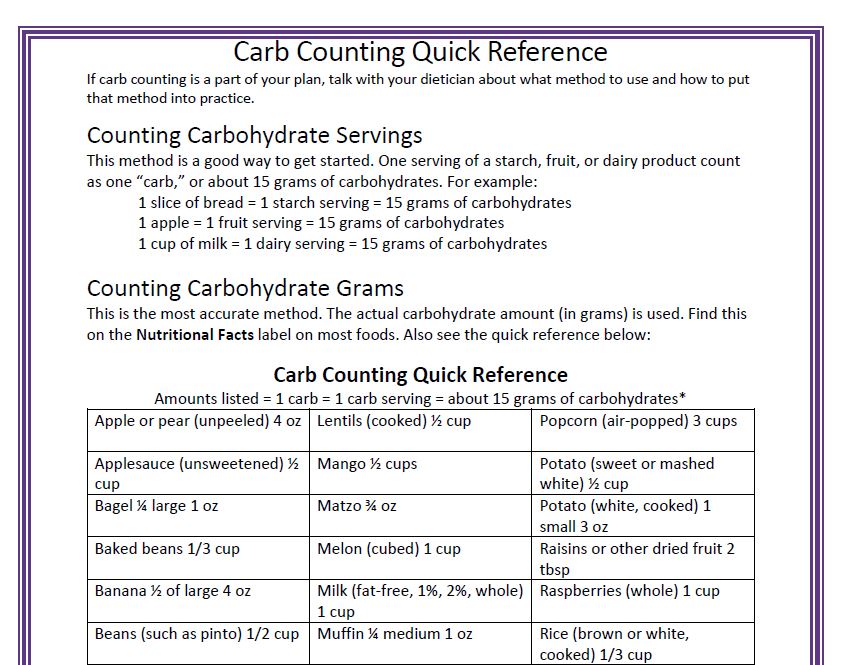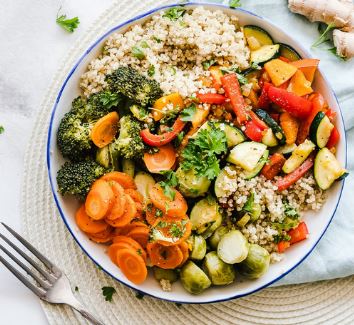Carb Counting Quick Reference | in English and Spanish

Download Here in Spanish
We created this Carb Counting Quick Reference sheet based on the ADA handbook. With the holidays and New Year around the corner, this cheat sheet of the most common carbs with serving size is a perfect reference for people counting carbs. Plus, it is perfect for exam prep for the health care professionals.
If you are studying for the diabetes certification exam, this reference provides the most common 15gm carb sources and their serving size. One exception is the milk serving – this list was created for people with diabetes and was simplified – we have modified it to reflect the actual carb count of a serving of milk (12 grams, not 15 grams of carbohydrates).
Learn more carb counting tips and tricks, and nutrition information in our Level 1 and 3 courses!

Start 2020 off right with Level 1 updates in January, Boot Camp (Level 3) updates in February and March, and a bundle to save on all the courses! We’re here to help make your New Year’s resolution a reality with great, on-demand videos, podcasts, handouts, extra resources, and practice tests to help you succeed at any diabetes certification exam.
Sign up for Diabetes Blog Bytes – we post one daily Blog Byte from Monday to Friday. And of course, Tuesday is our Question of the Week. It’s Informative and FREE! Sign up below!
[yikes-mailchimp form=”1″]Sugar Sweetened Beverages: Out of Sight and out of Mind

In a study conducted by University of California San Francisco’s (UCSF) Elissa Epel and colleagues, Epel wanted to evaluate the relationship between access to sugar-sweetened beverages (SSB) in the workplace and total daily consumption.
Epel and team banned the sale of all SSBs at UCSF for 10 months. Her team found that in employees deemed “frequent” SSB drinkers, consumption went down from 35 fluid ounces to a startling 17 oz.
Even though the employees still had access to SSBs outside of the campus, their consumption decreased significantly, highlighting the impact of eliminating access to SSBs in the work environment.
“This shows us that simply ending sales of sugary drinks in the workplace can have a meaningful effect on improving health in less than one year,” Epel said in a statement. “There is a well-known pathway from soda to disease. High sugar intake leads to abdominal fat and insulin resistance, which are known risk factors for diabetes, heart disease, cancer and even dementia. Recent studies have also linked sugar intake to early mortality.”
But this correlation was not enough for Epel. Before the ban went into effect, her team recruited 214 full-time employees who were self-reported “frequent” SSB drinkers. Epel and her team then randomly separated the employees into two groups: one group would receive a motivational intervention along with the SSB ban, while the other group wouldn’t receive any intervention. The motivational intervention included a 15-minute motivational session to begin and 5-minute calls one week, one month, and sixth months after the ban was put into effect.
The results were astounding; the participants in the intervention group consumed 25.4 oz less compared to the control group who only consumed 8.2 oz less.
Epel and her team had successfully proven a correlation between banning SSBs and consumption as well as a correlation between intervention and consumption. To read more about Epel’s study click here.
Sign up for Diabetes Blog Bytes – we post one daily Blog Byte from Monday to Friday. And of course, Tuesday is our Question of the Week. It’s Informative and FREE! Sign up below!
[yikes-mailchimp form=”1″]Changing your diet may lower depression
A new trial conducted by researchers at Macquarie University found a strong association between poor diet and depression. To conduct this trial, researchers split participants into two groups: one group ate a Mediterranean-style diet while the other control group continued to eat their usual diet.

They found that in the group that had changed their diet to eat healthier, depression levels decreased from moderate to non-depressed. The other group remained in the moderately depressed severity range.
“Highly processed foods increase inflammation,” researcher Heather Francis, a lecturer in clinical neuropsychology at Macquarie University in Sydney, Australia, told NPR via email. What’s more, “if we don’t consume enough nutrient-dense foods, then this can lead to insufficiencies in nutrients, which also increases inflammation,” she said.
The “healthy group” ate around six more servings of fruits and vegetables than the control group. They were also told to increase their intake of whole grains and healthy proteins and avoid processed foods.
NPR noted that this trial was not a stand alone. In 2017, one study found a link between eating a diet full of refined grains, red meat, and high-fat dairy products and depression.
Although there may be other factors affecting this data, such as the fact that there is no way to “blind” the participants (hence there’s the potential for placebo), this trial could be the first step to lower levels of depression. What this trial truly highlights is how much of one’s life can be affected by the food choices they make.
Read more on this study here.
Sign up for Diabetes Blog Bytes – we post one daily Blog Byte from Monday to Friday. And of course, Tuesday is our Question of the Week. It’s Informative and FREE! Sign up below!
[yikes-mailchimp form=”1″]
Baby Raegan’s 7 Strategies to Ditch Halloween Leftover Candies
Americans purchase nearly 600 million pounds of candy every year just for Halloween. That means lots of extra calories and sugar temptations for days and weeks to come.
One strategy to decrease temptation and consumption, is to remove these sugary treats from your home and donate leftover candy to persons or organizations in need. Donating provides a great opportunity to teach children about sharing and kindness, while supporting healthy food choices.

“Giving back to our Soldiers” provides a fantastic opportunity to express our gratitude by sharing these treats and maybe even adding a note of thanks for their service.
Operation Gratitude
Operation Gratitude sends care packages to U.S. troops stationed in overseas and first responders stateside. The organization’s mission is simple: to put a smile on soldiers’ faces. Kids are encouraged to include letters and pictures, too.
Soldiers’ Angels
Soldiers’ Angels organizes Treats for Troops annually. Visit the website to find a donation drop-off point, or register to start a drive of your own.
Operation Shoebox and Any Soldier
These are two more organizations that collect and send care packages to troops overseas. Operation Shoebox accepts individually wrapped candies all year long. Meanwhile, Any Soldier allows you to decide which branch of the armed forces you’d like to support: Army, Navy, Air Force, or Marines.
Here are some other strategies:
- Out of site, out of mind: Try keeping their favorite fruits and veggies in sight and put the candy somewhere where they have to dig for it.
- Trade treats for treasures: Plan a visit from the Halloween Witch.Tell your kids a tall tale about the Halloween Witch (or fairy). Like her cousin the Tooth Fairy, she sneaks in on the night of October 31 to spirit away candy–and leave a special toy or other gift in its place.Jennifer Tyler Lee posted this clever idea for reducing candy consumption on the Huffington post: Some parents invite their kids to leave a donation to the Switch Witch, who collects up Halloween candy and leaves a present in exchange. Similar to this idea, we’re going to trade treats for treasures. Five candies buys you a pack of hockey cards or a take-apart eraser. Twenty-five candies gets you a bucket of balls at the driving range. One hundred candies can be redeemed for tickets to the local college basketball game.
- Use candy for crafts: Use use the candy as the raw material to build a holiday house. Have your kids make a candy wreath by gluing packaged candies onto a wreath. Fun and decorative at the same time! A great way to use up extra candy and keeps the kids busy.
- Just add milk: Serve a glass of nonfat milk or water to enjoy with the candy. This will help balance what they are consuming and leave less room in their their stomach for more candy.
Sign up for Diabetes Blog Bytes – we post one daily Blog Byte from Monday to Friday. And of course, Tuesday is our Question of the Week. It’s Informative and FREE! Sign up below!
[yikes-mailchimp form=”1″]Free Resource Friday | Navigating Holiday Festivities
Whether it’s the candy, the turkey, stuffing, or the desserts, the holidays are a difficult time for anyone to eat healthy and avoid weight gain. Experts suggest that the holidays are not the best time to set weight loss goals. Instead, a more realistic approach is to focus on enjoying special events and weight maintenance coupled with lots of good self-care.

Weight watchers, most dietitians, and health bloggers suggest several strategies to make healthier choices when tempted by holiday fare:
- There is no need to eat to be polite – save calories or points for favorite foods. If there is lots of pressure, have 1-3 bites of whatever family or friends are suggesting.
- Be prepared for extra calories: maintain regular eating routine for the whole week leading up to the big meal. On the day of, make sure to have breakfast, and if the big meal is in the afternoon, have a small lunch or snack to avoid over-eating at the party.
- Drink calorie free beverages and choose vegetables or other low calorie options first before digging into the richer food choices.

Some interesting, alternative strategies that people are reporting success with:
- Plating up with a smaller plate: it tricks our brains into thinking we are eating more, and on average this strategy decreases intake by 40% or more.
- Wear something fitted and fabulous: boost self-confidence with an outfit that makes the wearer feel great about how they look, but also keeps them aware of quantity of food consumed.
- Take a walk after the meal instead of sinking into a recliner or couch to burn a few calories and keep metabolism revved up a bit longer.
Sign up for Diabetes Blog Bytes – we post one daily Blog Byte from Monday to Friday. And of course, Tuesday is our Question of the Week. It’s Informative and FREE! Sign up below!
[yikes-mailchimp form=”1″]Mindful Monday | Meals Around the World
Happy Mindful Monday! Today we’re offering a new perspective by showcasing dishes around the world. This comes from the New York Times after they interviewed 18 families around the world to see what their typical weeknight dinner is:
In Bangkok, Thailand:

Omelet with carrots, stir-fried minced pork and eggplant, and Thai sour curry with cauliflower is a common meal. Family members are expected to clean up after themselves and help cook at least one night a week.
In Gurgaon, India:

The Osan family eats around 9 p.m., normally with palak paneer (spinach with cheese), raita, kadai aloo (potatoes with onions and spices), cucumber salad and roasted chapatis.
In Rome, Italy:

The mother normally cooks for the rest of her family, and an easy weeknight meal includes saltimbocca (veal rolled with ham and sage), homemade pesto with trofie pasta, and baked tomatoes au gratin.
In Riyadh, Saudi Arabia:

The Khojandi family eats a mix of prepared and homemade foods during the weeknight. This includes smashed beans, shakshuka (eggs poached in a tomato and green pepper stew with onions and garlic), and masoob (a mix of banana, bread, dates, cream, and honey.
In Port-au-Prince, Haiti:

Many Haitian families take their main meal at midday. The Charles’ family prepares avocado, white rice, sos pwa nwa (black bean puree), beef and blue crabs marinated in orange and lime, and lalo (boiled jute leaves and chopped spinach).
In Rehovot, Israel:

The Levy family eats Yemeni soup, chicken schnitzel, chraime (white fish in tangy and spicy tomato sauce with smoked paprika and cilantro), with challah (bread) and rice.
In Paris, France:

In Paris, roasted chicken and couscous were part of an early dinner for the Devouges. Their meal ended with various cheeses (Petit Suisse, Comte, and Emmental).
In KwaZulu-Natal, South Africa:

Chakalaka (relish made with fried peppers, grated carrots, and baked beans) is a South African favorite. Ujeqe (steamed bread) and braised oxtail is a common weeknight meal.
In Western Australia:

The Opie family eats pan-fried nannygai (red snapper), broccolini, and sweet potato fries for dinnr. Their children get extra fruits and vegetables like strawberries, raspberries, snow peas, and carrots.
In Amsterdam, Netherlands:

The Henkets eat a dinner of salmon with basmati rice and broccoli and a dessert of homemade custard with fresh raspberries and berry jam.
In Lagos, Nigeria:

In Lagos, their meal revolves around the sauces. With plantain flatbreads and chicken suya, condiments include peanut butter sauce, papaya chutney, hibiscus green chile sauce, mint and spring onion oil, tamarind ginger sauc, and beet and carrot sauerkraut.
In Monterrey, Mexico:

Huevos revueltos (scrambled eggs with chorizo and onions, served with flour tortillas) is a staple, even for dinner.
In Moscow, Russia:

Liza prepares dinner for her husband and six children. While she cooks, the children and her husband are in charge of setting the table. Kotleti (beef patties with bread, egg, and onion), rice, green salad, and an eggplant, red pepper, basil salad make for a perfect weeknight meal.
In Tokyo, Japan:

Fish, rice, and miso soup are a classic Japanese meal. Yasuko cooks for her adult son a few nights a week, with mebaru (rockfish) being on the menu that night. Fresh fruit serves as dessert.
In Istanbul, Turkey:

Kofte (meatballs), lentil soup, bulgur pilaf with tomato and bell pepper, dolmas (stuffed grape leaves) and red beans in olive oil make up the Terzi family dinner. A rice pudding called sutlac with tahini and walnuts is for dessert.
In Sao Paulo, Brazil:

In Brazil, the mom cooks the meal of picadinho (beef, potato and carrot stew) with rice and salad, while the dad sets the table. The children are expected to clean up afterward.
Read full descriptions and see in-home photography from the New York Times report!
Sign up for Diabetes Blog Bytes – we post one daily Blog Byte from Monday to Friday. And of course, Tuesday is our Question of the Week. It’s Informative and FREE! Sign up below!
[yikes-mailchimp form=”1″]Nutrition Counseling under utilized in spite of Medicare coverage
There are approximately 15 million people enrolled in Medicare who have diabetes or chronic kidney disease which is eligible for the benefit of personal nutritional counseling.
Medicare pays for the first three hours of dietary counseling during the first year the benefit is used, and two hours in subsequent years.

Only 5% of Medicare beneficiaries receive Medical NutritionTherapy Counseling. Yet, participants who receive counsel from Registered Dietitians have A1c drops of 1-2%.
Kaiser Health News gathered testimonials from people who took advantage of the nutritional counseling referral and people found it help to bring down their blood glucose readings and realize what and what not to eat and portion sizes. One man, Louis Rocco, didn’t realize until seeing a dietitian that eating a lot of bread could be dangerous for him. He said “I’m Italian, and I always eat a lot of bread,” but he could see the difference in his readings after two, hour-long consultations with a dietitian.
The problem may be that not enough physicians know about the Medicare benefit. Doctors have to refer patients to a dietitian. See Kaiser Health News for the full article.
Sign up for Diabetes Blog Bytes – we post one daily Blog Byte from Monday to Friday. And of course, Tuesday is our Question of the Week. It’s Informative and FREE! Sign up below!
[yikes-mailchimp form=”1″]Nordic Diet – Better than Mediterranean?
Developed in tandem by scientists, nutritionists, and chefs, the Nordic diet was designed to enhance the nutritional intake of people in Scandinavian Countries. The Nordic diet is similar to the Mediterranean diet in that it promotes healthy lifestyle habits like choosing local, fresh ingredients and pairing diet with active habits like bicycling and walking.
The Nordic diet’s aim is to limit sugar and highly processed foods while emphasizing whole and minimally processed foods; high-fiber vegetables, whole grains, fruit, dense breads (pumpernickel/real sourdough), fish, low-fat dairy, lean meats of all types, beans and lentils, tofu, skinless poultry, and fermented foods.
The Nordic Diet ratio recommends 50% of calories from high fiber carbs, 25% lean protein, and 25% from mostly plant based fats. Fermented foods — fish, vegetables and dairy — also play a strong role, as do herbs and spices
A caveat is if you live in a warmer climate, some of the Nordic foods may be difficult to find, so the Mediterranean diet may be better. Also, registered dietitian Layne Lieberman advises limiting cured fish which is high in salt, sugar, and often nitrates. Read more about the Nordic diet here.
Sign up for Diabetes Blog Bytes – we post one daily Blog Byte from Monday to Friday. And of course, Tuesday is our Question of the Week. It’s Informative and FREE! Sign up below!
[yikes-mailchimp form=”1″]








